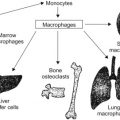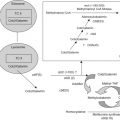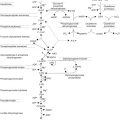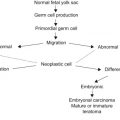Abstract
Lymphoproliferative disorders manifest with uncontrolled hyperplasia of lymphoid tissues (lymph nodes, spleen, bone marrow, liver). They are a heterogeneous group of diseases that range from reactive polyclonal hyperplasia (immunologic disorders) to true monoclonal (malignant) diseases.
Keywords
AILD, chemotherapy, Epstein–Barr virus (EBV), GVHD, lymphoproliferative disorders, Castleman disease, acute lymphoblastic leukemia, HSCT, autoimmune lymphoproliferative syndrome (ALPS)
Lymphoproliferative Disorders
Lymphoproliferative disorders (LPDs) manifest with uncontrolled hyperplasia of lymphoid tissues (lymph nodes, spleen, bone marrow, liver). They are a heterogeneous group of diseases that range from reactive polyclonal hyperplasia (immunologic disorders) to true monoclonal (malignant) diseases.
Angioimmunoblastic Lymphadenopathy with Dysproteinemia
Manifestations of this clinicopathological syndrome include:
- •
Generalized lymphadenopathy (80%).
- •
Hepatosplenomegaly (70%).
- •
Fever (70%), malaise, weight loss, polyarthralgia.
- •
Quantitative changes in serum proteins (polyclonal hypergammaglobulinemia, 70%); hypocomplementemia.
- •
Autoantibodies; circulating immune complexes, antismooth muscle antibody.
- •
Rashes.
- •
Pulmonary infiltrates, pleural effusions.
- •
Thrombocytopenia.
- •
Hemolytic anemia (often direct antiglobulin test (Coombs’) positive).
Diagnosis
The lymph node shows architectural effacement, absence of germinal center, arborization of postcapillary venules, and a polymorphous infiltrate that includes immunoblasts and plasma cells. Immunoblasts are CD4-positive. Lymph node cytogenetic studies have shown non-random abnormalities, including +3, 14q+, and del(8) (p21). Angioimmunoblastic lymphadenopathy with dysproteinemia (AILD) was previously considered to be a benign LPD with the potential to transform into lymphoma. Since it is a monoclonal disorder, it is now recognized as a type of angioimmunoblastic peripheral T-cell lymphoma.
Prognosis
The prognosis is poor. Death usually results from overwhelming infection. The median overall survival is 1.5 years.
Treatment of AILD-Type Lymphoma
Chemotherapy: Adriamycin-containing regimens such as CHOP (see Table 16.7 ) have been used. Various combinations including fludarabine, lenalidomide, and bortezomib are often used in salvage regimens with variable success.
Small Lymphocytic Infiltrates of the Orbit and Conjunctiva (Ocular Adnexal Lymphoid Proliferation, Pseudolymphoma, Benign Lymphoma, Atypical Lymphocytic Infiltrates)
Lymphocytic infiltrates of the orbit and conjunctiva may be divided into three histologic groups:
- •
Monomorphous infiltrates of clearly atypical lymphocytes.
- •
Infiltrates composed of small lymphocytes with minimal or no cytologic atypia.
- •
Benign inflammatory pseudotumor or reactive follicular hyperplasia.
On the basis of immunophenotypic criteria, they can be divided into two classes:
- •
Infiltrates with monotypic immunoglobulin expression.
- •
Infiltrates with polytypic immunoglobulin expression.
For the localized small lymphocytic infiltrates, monotypic (monoclonal) immunoglobulin expression confers a 50% risk of dissemination. The initial immunophenotypic (monoclonal or polyclonal) and molecular studies of various histologic groups fail to correlate with the eventual outcome of these cases because the initial polyclonal tumors may become monoclonal.
All patients presenting with small lymphocyte infiltrates of the orbit and conjunctiva should have a systemic evaluation with serum chemistries, blood counts, and appropriate imaging studies at initial diagnosis and every 6 months for 5 years thereafter.
For localized disease, local radiotherapy is commonly used, regardless of histologic grading. DNA from Chlamydia psittaci has been isolated in a large percentage of biopsies and treatment with doxycyline may be efficacious.
Angiocentric Immunolymphoproliferative Disorders
These are a collection of entities classified as peripheral T-cell disorders and include lymphomatoid granulomatosis, midline granuloma, and post-malignancy angiocentric immunolymphoproliferative (AIL) lymphoma.
There are three grades of AIL disorders:
- •
Grade I : Polymorphic infiltrates with minimal necrosis, few large atypical lymphoid cells, and small lymphocytes lacking nuclear irregularities.
- •
Grade II : Cytologic atypia of small lymphocytes, scattered large atypical lymphoid cells, and intermediate amount of necrosis.
- •
Grade III : Lymphoma, either diffuse, mixed, large cell, or immunoblastic, with prominent necrosis.
The cellular origin of AIL lymphoma remains uncertain because of the following findings:
- •
Immunophenotype of T-cells (CD2+, CD3+, CD4±, CD5±, CD7±).
- •
Absence of clonal rearrangements of T-cell receptors (TCRs).
- •
Expression of natural killer (NK) cell antigens (CD16+, CD56+, CD57+).
AIL lymphoma has been postulated to be a clonal process induced by Epstein–Barr virus (EBV) infection of T lymphocytes.
Clinical Features
Lymphomatoid Granulomatosis
This is a systemic disease in which the lungs are typically involved. Patients may present with cough, dyspnea, and chest pain, or they may be asymptomatic and discovered incidentally on a chest radiograph. Chest radiographs may show bilateral nodules, consolidation, diffuse bilateral reticulonodular infiltrates, lymphadenopathy (mediastinal and/or hilar), and/or pleural effusion. Purplish skin nodules occur and may undergo spontaneous central necrosis and ulceration. The kidneys, central nervous system (CNS), skeletal muscles, nasopharynx, or peripheral nerves may also be involved.
Midline Lethal Granuloma
This presents with a progressive necrotizing and destructive process involving the upper airways. There may or may not be a tumor mass. The most common sites of the disease are the nasal fossa, nasal septum, nasopharynx, palate, and adjacent soft tissue or bony structures. There is often a history of longstanding sinusitis with purulent and foul-smelling nasal discharge.
Postmalignancy Angiocentric Immunolymphoproliferative Lymphoma
This rarely occurs in children and most commonly occurs after a history of acute lymphoblastic leukemia (ALL). The interval between the remission of ALL to the diagnosis of AIL lymphoma ranges from 1 month to 4–5 years. The prognosis is poor.
Treatment
There is no standard treatment; the majority of patients are treated with chemotherapy based on adult non-Hodgkin lymphoma protocols and rituximab. The most commonly used agents are cyclophosphamide, prednisone, adriamycin, and vincristine.
Castleman Disease (Angiofollicular Lymph Node Hyperplasia, Benign Giant Lymph Node Hyperplasia, Angiomatous Lymphoid Hamartoma)
Castleman disease is characterized by an accumulation of nonmalignant lymphoid tissue interspersed with plasma cells and blood vessels.
Vascular hyperplasia has been attributed to a humoral vasoproliferative factor.
Table 16.1 shows the relationship between histologic types and clinical features in Castleman disease.
| Histologic type (frequency) | Disease sites | Symptoms |
|---|---|---|
| Hyaline vascular type (80%) | Solitary lymph node 1.5–16 cm or chain of lymph nodes; two-thirds in mediastinum; sometimes other sites such as peripheral lymph nodes, abdomen and pelvis | >90% Asymptomatic; pressure effects referable to the location of the mass may be present; 5–10% patients have constitutional symptoms |
| Plasma cell variety (20%) |
|
|
The production of interleukin-6 (IL-6) by B-cells in the germinal centers of hyperplastic lymph nodes in Castleman disease plays a central role in inducing the variety of symptoms in this disease. In localized disease, human herpes virus 8 (HHV-8) DNA sequences have been detected in CD19 B-cells. In multicentric disease, HHV-8 sequences have been detected in CD19 B-cells and CD2 T-cells.
Clinical Features
Unicentric Hyaline Vascular Variant
- •
Single lymph node or chain: cervical and mediastinal nodes most common.
- •
Five to ten percent of patients have constitutional symptoms, but most are asymptomatic.
- •
May have reactive diffuse shotty nonpathologic lymphadenopathy.
- •
Associated with thrombotic thrombocytopenic purpura.
Unicentric Plasma Cell Variant
- •
Single lymph node or chain: abdominal nodes most common.
- •
Associated with increased IL-6.
- •
May have reactive diffuse shotty nonpathologic lymphadenopathy and splenomegaly.
- •
Frequently have constitutional symptoms, hematologic abnormalities (anemia, thrombocytopenia, lymphocytosis), hypoalbuminemia, and hypergammaglobulinemia.
Multicentric Plasma Cell Variant
- •
Similar clinical presentation as unicentric plasma cell variant; however, it involves multiple lymph nodes and chains. Hepatosplenomegaly is more common.
- •
May also have neurologic manifestations, peripheral edema, ascites, and pleural effusions.
- •
Associated with HIV and HHV-8 infections.
Prognosis
Localized disease: Excellent.
Multicentric disease: Poor. A minority with multicentric disease progress rapidly and develop hemolytic anemia and fatal intercurrent infection. Some develop non-Hodgkin lymphoma or Kaposi sarcoma.
Treatment
Localized disease: Surgical resection is curative. If complete resection is not possible, prednisone may be used to reduce size to enable complete surgical resection. Local radiation may be used for nonresectable disease.
Multicentric disease:
- •
Glucocorticoids alone or with vincristine.
- •
Monoclonal antibodies: anti-IL-6, anti-IL-6 receptor, anti-IL-1 receptor, and anti-CD20 antibodies have been used successfully.
- •
Multiagent chemotherapy (see Table 16.7 ) with rituximab is considered the standard of care.
EBV-Associated LPDs in Immunocompromised Individuals
EBV is a gamma herpes virus, a subfamily distinguished by its limited tissue tropism and latency. EBV enters via the oropharyngeal route and infects resting B lymphocytes through the interaction between the EBV viral envelope glycoprotein (gp350/220) and the C3d complement receptor (CD21). Infected B-cells induce immunologic response of both virus-specific and –non-specific T-cells during primary infection which leads to regression of the majority of infected B-cells. However, the virus persists in its latent state lifelong, by its continued presence in a small number of B-cells, which express latent membrane protein 2A and small EBV-encoded RNA 1 and 2 (EBERs 1 and 2). Table 16.2 lists the functions of EBV latent antigens.
| EBV antigen | Function |
|---|---|
| LMP1 | Prevention of apoptosis (through NFκB and MAPK, induction of antiapoptotic proteins AP-1, bcl-2) and immortalization of B-cells, increase in tumor invasiveness (by induction of matrix metalloproteinase) |
| LMP 2A | Inhibits lysis of B-cells |
| Lytic antigens | vIL-10 and BHRF1 facilitate lysis of cells and induce survival and proliferation of nearby, latently infected B-cells |
| EBNA 1 | Maintenance and replication of the EBV episome in latency |
| EBNA 2 | Has an immortalizing function |
EBV Antigens Associated with the Lytic Cycle
- •
Early antigen.
- •
Viral capsid antigen (VCA).
During acute infectious mononucleosis (AIM) humoral responses are directed against both lytic and latent proteins. Immunoglobulin M (IgM) antibodies to cellular proteins and heterophile antigens are also present during AIM.
Detectable levels of IgG antibodies to VCA and EBNA1 persist through lifetime.
In conjunction with humoral response, the CD4 and CD8 T-cell-mediated responses also play an important role in controlling the EBV infection by identifying and destroying latently infected cells.
Cellular Responses in the Control of EBV Infection
The lymphocytosis during AIM consists of activated CD4 and CD8 T lymphocytes. They are specific for EBV lytic and latent proteins.
| Cell | Reactivity (function) |
|---|---|
| CD8+ and CD4+ T-cells | Directed toward latent phase proteins: EBNA3, EBNA4, LMP1, EBNA6 |
| Natural killer cells | Lysis of virus-containing cells during lytic phase |
Reasons for Persistence of Latency in EBV Infection
- •
Paucity of production of neutralizing antibodies to the gp 350/220 component of the viral glycoprotein, a ligand for interaction with C3d on B-cells.
- •
Absence of cytotoxic T lymphocytes (CTL) response to EBNA1 which is primarily responsible for replication of and maintenance of viral genome during host cell division.
A state of balance between the control of EBV infection in latent state and host’s immune response is achieved in a healthy host after the control of AIM phase. However, this state of balance is offset if the host is immunocompromised. Under this situation, the EBV can proliferate and can cause chronic active EBV infection, hemophagocytic lymphohistiocytosis (HLH), LPD, lymphomas, and other rare complications.
The following immunodeficiencies are associated with the development of LPDs and often require hematopoietic stem cell transplant for cure.
- •
Inherited non-EBV specific immunodeficiencies.
Patients with the following immunodeficiencies have difficulty fighting EBV, as well as other infections and viruses:
- •
Ataxia telangiectasia.
- •
Wiscott–Aldrich syndrome.
- •
Common variable immunodeficiency (CVID).
- •
Severe combined immunodeficiency.
- •
Antibody deficiency syndromes such as hypergammaglobulinemia, hyper IgM syndrome, X-linked agammaglobulinemia, IgA and IgG subclass deficiency.
- •
Bloom syndrome.
- •
Chédiak–Higashi syndrome.
- •
Inherited EBV-specific immunodeficiencies.
- •
X-linked lymphoproliferative (XLP).
- •
XMEN: X-linked magnesium deficiency with EBV infection and neoplasia. This is a rare immune deficiency caused by low CD4 T cells and uncontrolled chronic EBV infection. Caused by mutations in magnesium transporter 1 (MagT1).
- •
ITK deficiency: A rare inherited autosomal recessive disorder caused by mutations in ITK, leading to severe immune dysregulation following EBV infection.
- •
X-linked inhibitor of apoptosis protein (XIAP) deficiency: A rare disorder caused by mutations in BIRC4 and originally thought to be a form of XLP in patients without SH2D1A mutations because the initial reported cohorts only included patients with EBV HLH. However, it is now recognized to include a wider phenotype that can manifest with splenomegaly, uveitis, inflammatory bowel disease, EBV LPD, antibody deficiency, skin infections, and/or EBV HLH.
Biological Factors of Significance Involved in the Pathogenesis of LPDs in this Population
- •
EBV, which causes B-cell proliferation.
- •
Imbalanced production of cytokines (e.g., predominance of IL-4 and IL-6 activates B-cells, i.e., humoral arm of immune system).
- •
Genetic defects resulting in ineffective or aberrant rearrangement of TCR and immunoglobulin genes.
Iatrogenically Induced Immunodeficiencies
- •
Organ transplantation recipients : Long-term treatment with immunosuppressive drugs, including the calcineurin inhibitors cyclosporine and tacrolimus, increases the risk of infections with EBV. EBV status of the organ transplantation recipient plays a significant role. If the patient is EBV-seronegative and the donor is seropositive, then the risk of developing clinical infectious mononucleosis followed by LPD increases remarkably. The incidence is higher in children than adults and it is more likely to present with clinical features of fulminating infectious mononucleosis. Many children have not been previously exposed to EBV and, thus, are more likely to develop a primary EBV infection. Post-transplantation LPDs (PT-LPDs) after SOT are of B-cell origin and are associated with EBV infection in most patients. A few cases of T-cell PT-LPDs have been reported.
- •
Hematopoietic stem cell transplantation (HSCT) recipients : HSCT differs in the following aspects: The patient receives a new immune system from a donor who is either a full histocompatibility locus antigen (HLA) match or a partial HLA match. The patient’s immune system is ablated prior to HSCT. HSCT may require T-cell depletion of the donor’s bone marrow.
The complete recovery of the donor’s immune system is delayed by the use of cyclosporine, methotrexate, prednisone, and calcineurin inhibitors, which are used to prevent rejection of graft and graft-versus-host disease (GVHD). It takes 6 months to 2 years for immunologic recovery to occur. LPD after HSCT is also associated with EBV-infected B-cells. The incidence of LPD in standard matched HSCT is low, but it is 6–12% in HLA-mismatched HSCT due to an increased use of T-cell depletion of the donor’s marrow. Also, the use of antithymocyte globulin (ATG) or alemtuzumab (Campath) in a preparative regimen increases the risk of PT-LPD. Depletion of both T- and B-cells from the graft is associated with a lower incidence of PT-LPD, since, by removing B-cells, it depletes the graft of latent virus creating a balance between latent virus and cellular T-cell immunity. PT-LPD has also been reported after autologous transplantation after CD34+ selection, resulting in complete depletion of lymphocytes.
Table 16.3 shows a classification of PT-LPDs.








